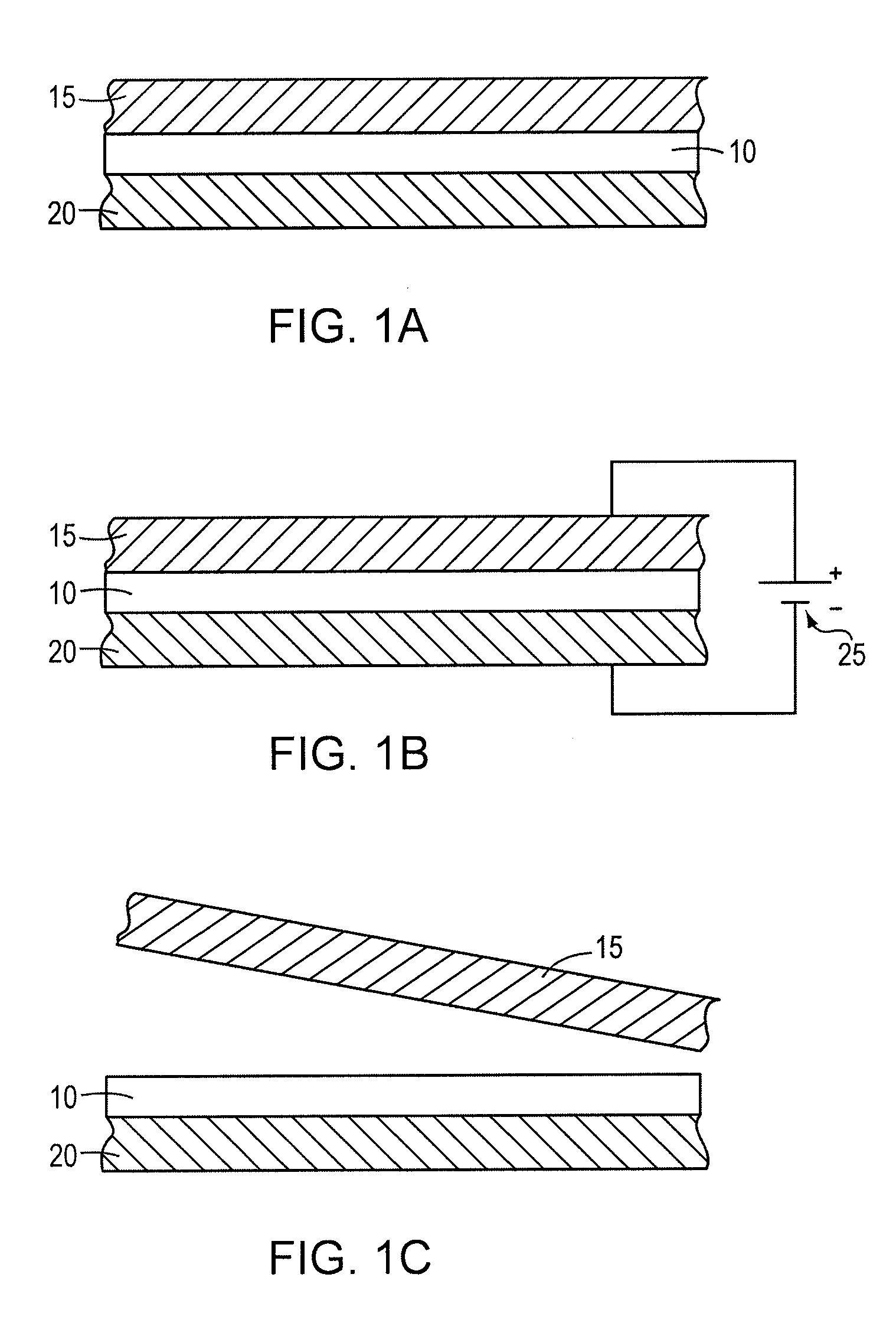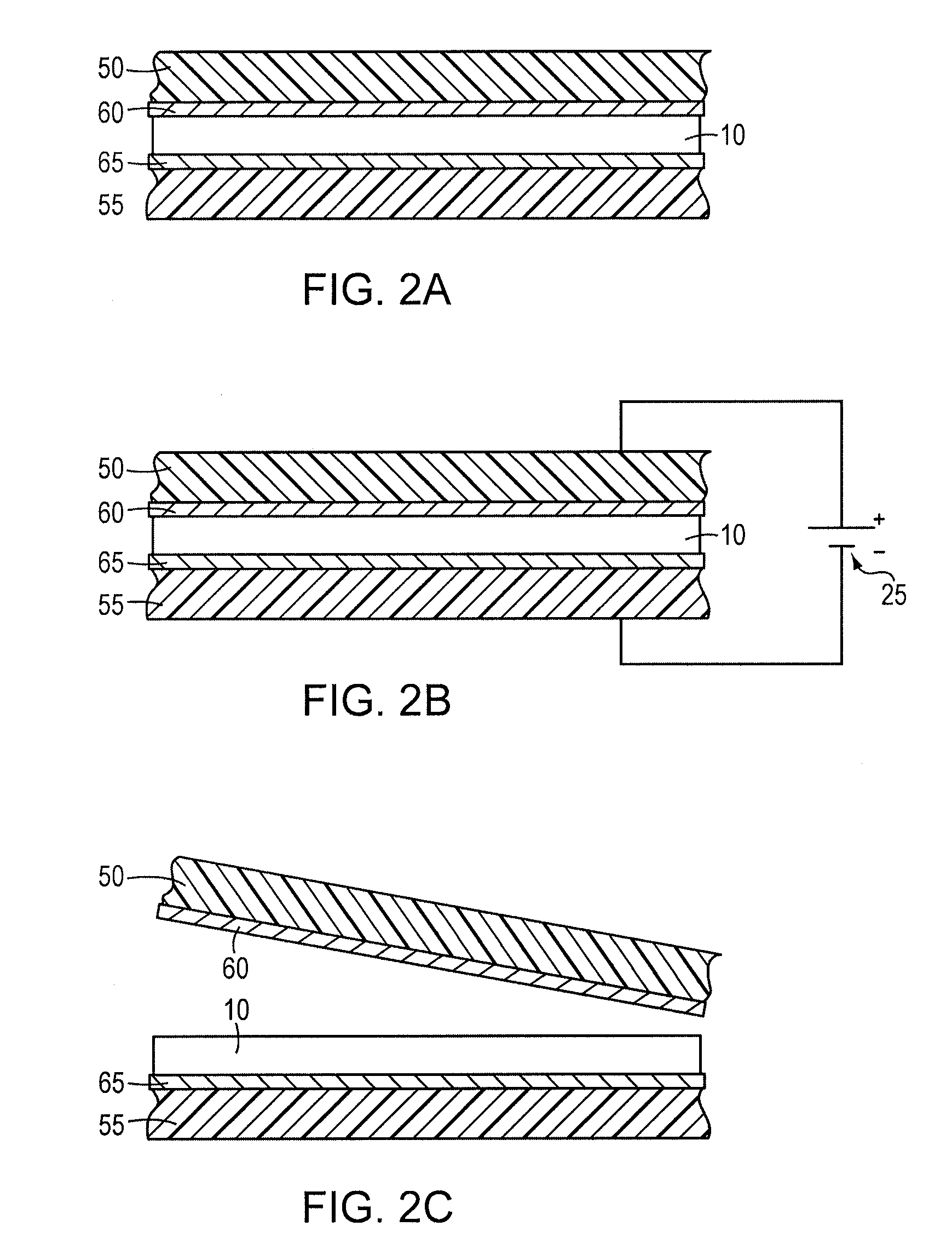Electrically Disbonding Adhesive Compositions and Related Methods
- Summary
- Abstract
- Description
- Claims
- Application Information
AI Technical Summary
Benefits of technology
Problems solved by technology
Method used
Image
Examples
example 1
[0054]An electrically releasing hot-melt adhesive was formulated by mechanically mixing 4.95 grams of polycaprolactone (Mn 42,500 AMU with 0.5 gram of finely divided poly(epichlorohydrin) rubber (Hydrin C2000XL, Zeon Chemicals) at 150° C. until the rubber dissolved. This mixture was combined with 2.48 grams of phenolic resin (SP-25, SI Group), which serves as the tackifier, 0.25 gram of sodium perchlorate electrolyte and 0.55 gram of microcrystalline wax (softening point 85-90° C.). The composition was then mixed at 150° C. until well blended. Finally, 1.2 grams of tetraethylene glycol dimethyl ether (tetraglyme) plasticizer were stirred into the composition along with 0.1 gram of water. The mixture was cooled to room temperature forming a solid suitable for use as a hot-melt adhesive.
[0055]An electrically releasing bond was fabricated using this composition to bond two aluminum surfaces by first heating the composition until molten (between 120-150° C.) and then applying the molten...
example 2
[0056]An electrically releasing hot-melt adhesive exhibiting substantially total reduction in adhesive bond strength was formulated by mixing 4.47 grams of polycaprolactone (Mn. 44.5K) and 1.12 grams of polyepichlorohydrin rubber at 150° C. and mechanically stirring until the rubber dissolved in the molten polycaprolactone. To this mixture was then added 1.12 grams of SP-25 phenolic resin, 1.12 grams of pentaerythritol tetrabenzoate, 0.22 gram of sodium perchlorate and 0.34 gram of paraffin wax (softening point 54° C.). The mixture was heated at 150° C. and stirred until a homogeneous blend was obtained. To this were added 1.57 grams of tetraglyme and 0.05 gram of water. The blend was stirred and then cooled to room temperature.
[0057]Bonded specimens are fabricated with this composition following the procedure described in Example 1. Bonds formed between aluminum surfaces exhibited a tensile strength of 175 psi, which decreased to <10 psi after application of 50 V dc across the bond...
example 3
[0058]An electrically releasing hot-melt adhesive exhibiting both a high initial adhesive strength and low residual adhesive strength after electrical disbonding was formulated by blending of 4.8 grams of polycaprolactone (Mn 44.5K) with 0.48 gram of polyepichlorohydrin rubber at 150° C. and stirring until the rubber dissolved in the molten polymer. To this mixture were then added 2.4 grams of SP-25, 0.48 gram of pentaerythritol tetrabenzoate, 0.24 gram of sodium perchlorate and 0.36 gram of paraffin wax. The mixture was stirred further at 150° C. until a homogeneous liquid was formed. To this were added with mixing 1.2 grams of tetraglyme and 0.05 gram of water. The mixture was then cooled to room temperature.
[0059]Aluminum surfaces specimens fabricated with this hot-melt adhesive composition exhibited a tensile strength of 600 psi, dropping to <10 psi after 50 V was applied across the bondline for 3 minutes. The bond was weakened most effectively at the interface between the hot-m...
PUM
| Property | Measurement | Unit |
|---|---|---|
| Electrical conductivity | aaaaa | aaaaa |
| Electrical conductivity | aaaaa | aaaaa |
| Electric potential / voltage | aaaaa | aaaaa |
Abstract
Description
Claims
Application Information
 Login to View More
Login to View More - R&D
- Intellectual Property
- Life Sciences
- Materials
- Tech Scout
- Unparalleled Data Quality
- Higher Quality Content
- 60% Fewer Hallucinations
Browse by: Latest US Patents, China's latest patents, Technical Efficacy Thesaurus, Application Domain, Technology Topic, Popular Technical Reports.
© 2025 PatSnap. All rights reserved.Legal|Privacy policy|Modern Slavery Act Transparency Statement|Sitemap|About US| Contact US: help@patsnap.com



